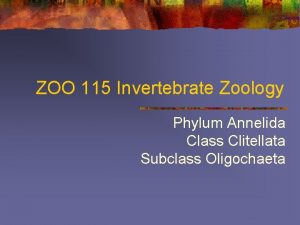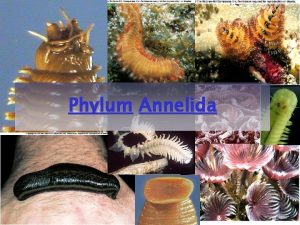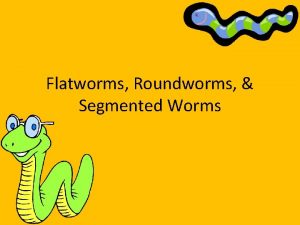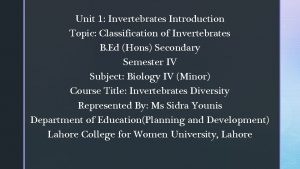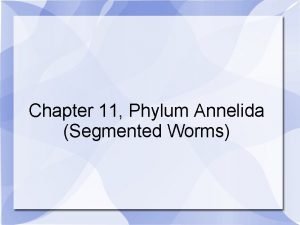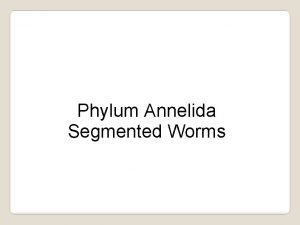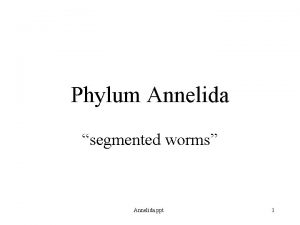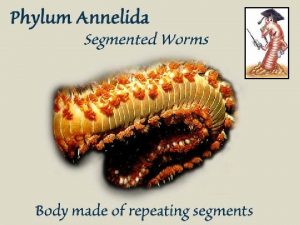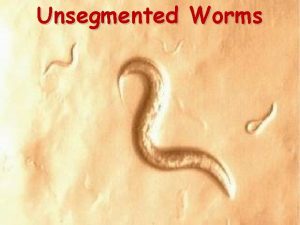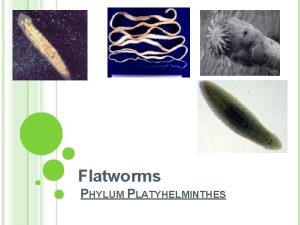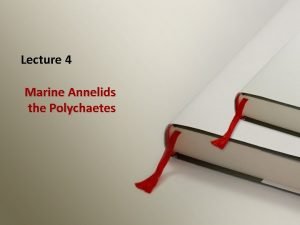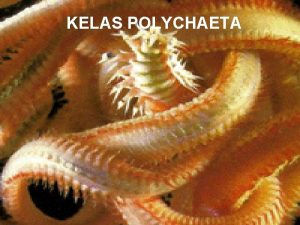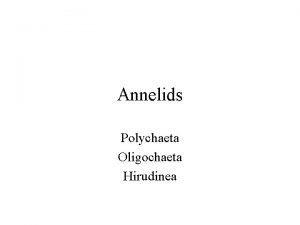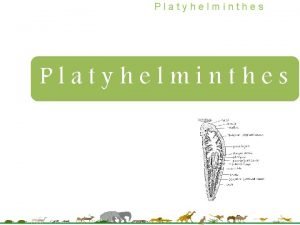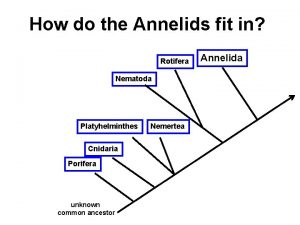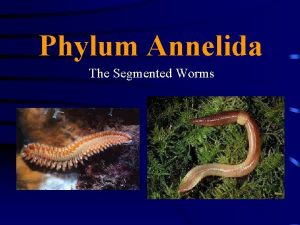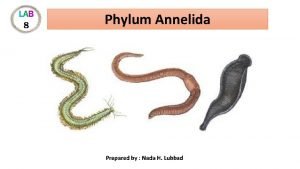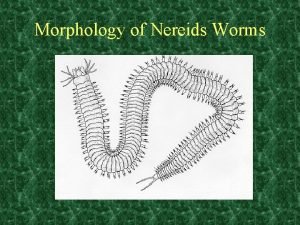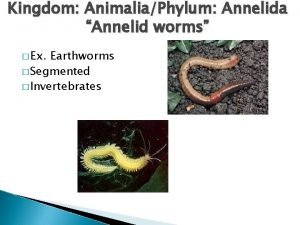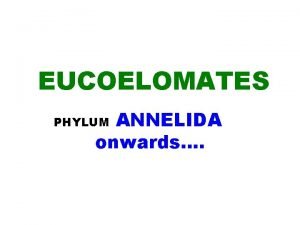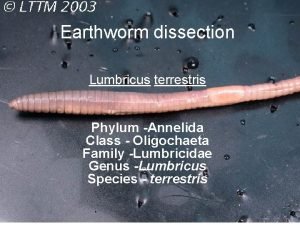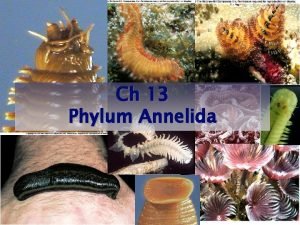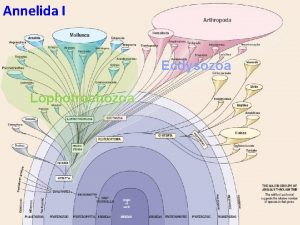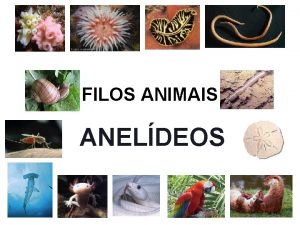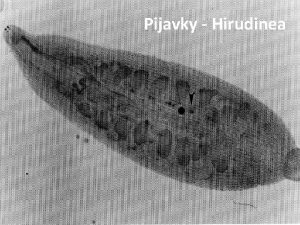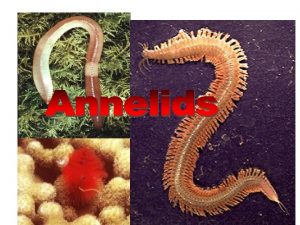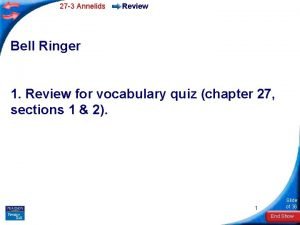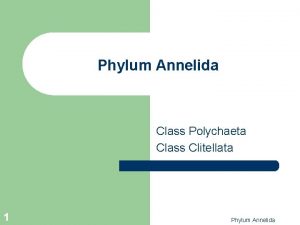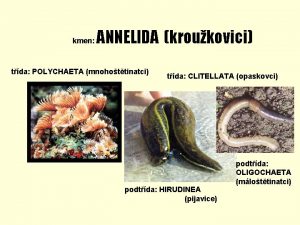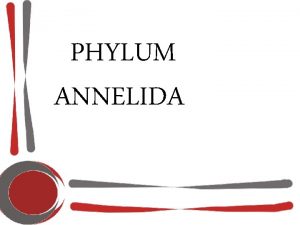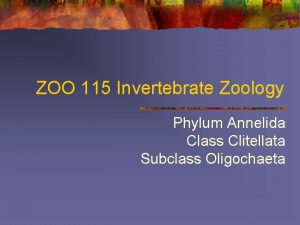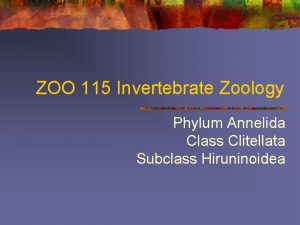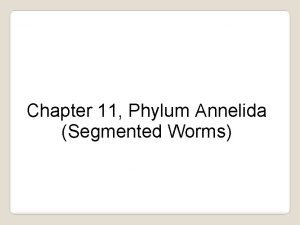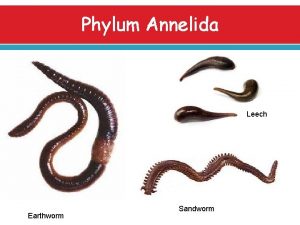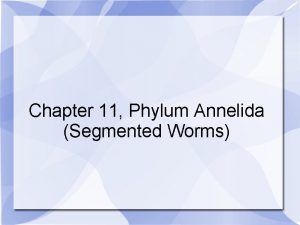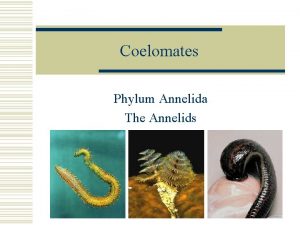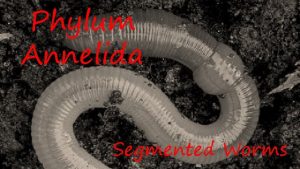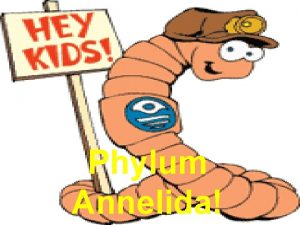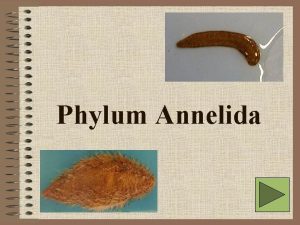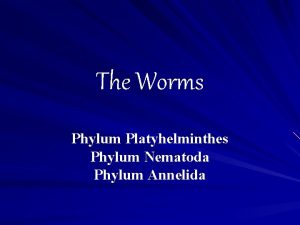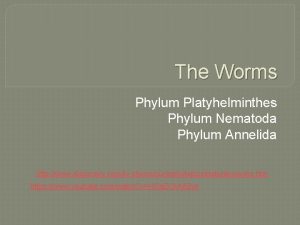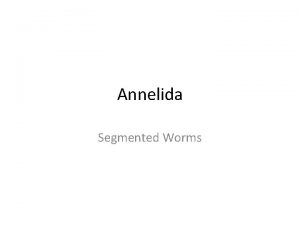Phylum Annelida Class Polychaeta Class Clitellata Class Aelosomata
































- Slides: 32


Phylum Annelida Class Polychaeta Class Clitellata Class Aelosomata Marine worms Subclass Errantia Subclass Sedentaria Subclass Oligochaeta earthworms Subclass Hirudinae Leeches

Class Polychaeta • marine worms • segmented Class Clitellata Subclass Oligochaeta • earthworms • segmented Subclass Hirudinea • Leeches • segmented

• • • Segmentation (metameric body plan) Eucoelomate 15, 000 species Closed circulatory system, but no heart Hydrostatic skeleton Excretion- protonephridia, metanephridia, diffusion or gills Simple gut Respiration- diffusion or gills Central nervous system- brain and nerve cord Reproduction- asexual or sexual (many gonochoric) Sensory system of tactile organs, taste buds, statocysts, photoreceptor cells, and eyes with lenses.

Subclass Oligochaeta • Lack parapodia and have few setae • Lack the distinctive head region of polychaetes and have no eyes. • Scavengers that consume soil that contains organic matter • The ingested soil moves into a storage chamber called the crop, then to an area called the gizzard, where grinding action breaks down the soil particles. Undigested material passes out the anus in a form called castings, which are prized as soil fertilizer.

Metamerism (segmentation) • Each segment is also known as a metamere • Each metamere has a parapodia with numerous setae parapod chaetae

Body Cavities Mesoderm Eucoelomatebody cavity completely lined with mesoderm coelom gut Ectoderm Endoderm

Hydrostatic Skeleton Earthworm Phylum Annelida

Closed Versus Open Circulatory Systems

Closed Circulatory System

Nervous System and Behavior • A mass of ganglia (neural masses) forms an anterior brain that is usually dorsal to the pharynx. • They have either a pair of ventral nerve cords (primitive) or a single ventral nerve cord that runs the length of the body. • Each segment has a swelling of the nerve cord called a segmental ganglion. • Sensory receptors include: chemoreceptors, touch receptors, photoreceptors, statocysts and vibration receptors. • Behaviors vary depending on class/life style.

Oligochaete Nervous System

Digestive System Esophagus Gizzard Pharynx Crop Buccal cavity Mouth Intestine

Reproductive System Seminal vesicle Testes Seminal receptacle Ovary Sperm duct Egg funnel and oviduct

Oligochaete Reproduction

Oligochaete Excretory System

Subclass Hirudinea Leeches • Most live in fresh bodies of water, but some live among moist vegetation. • Suckers found on both ends • Unlike other annelids, its segments are not separated internally • Leeches lack both setae and parapodia • Most are predators or scavengers. Very few are parasites. • They secrete anticoagulants, hirudin, to keep blood from clotting and anesthetic that prevents the host from feeling their presence.

Subclass Hirudinea

Hirudo medicinalis

Class Polychaeta • Largest group of annelids • Primarily marine • Most segments include a pair of paddle–like parapodia • Well-developed head with eyes and other sensory structures

Class Polychaeta Subclass Sedentaria • • • Fan worms, Christmas-tree worms Spaghetti worms Chaetopterus lugworms Subclass Errantia • Sand worms, • Scale worms • Fire worms • palolo worms

featherduster worms Subclass Sedentaria

Lugworm Subclass Sedentaria

Chaeopteris Subclass Sedentaria

Spaghetti worm Lanice conchilega • • Hawaii has 11 species 5 are endemic Subclass Sedentaria

Christmas tree worms Spirobranchus giganteus Subclass Sedentaria

Scale worm 1. Subclass Errantia

Fire worm 1. Eurythoe complanata Subclass Errantia

The pharynx is everted by contraction of body wall muscles.

Parapodia- movement and respiration

Polychaete Trochophore Larvae

Polychaete Larvae (setiger)
 Subclass oligochaeta
Subclass oligochaeta Annelida
Annelida Pseudocoelomate flatworm
Pseudocoelomate flatworm Millipedes phylum
Millipedes phylum Annelida
Annelida Peranan annelida
Peranan annelida Trocophore larva
Trocophore larva Annelida
Annelida Feather duster worm anatomy
Feather duster worm anatomy Body plan
Body plan Belongs to which phylum
Belongs to which phylum Platyhelminthes
Platyhelminthes Parapodia in polychaetes
Parapodia in polychaetes Kelas polychaeta
Kelas polychaeta Nereis cross section
Nereis cross section Heliplas
Heliplas Kelas polychaeta
Kelas polychaeta Annelida characteristics
Annelida characteristics Annelids
Annelids Morphology of annelida
Morphology of annelida Earthworms belong to the kingdom
Earthworms belong to the kingdom Annelida vs nematoda
Annelida vs nematoda Annelida
Annelida Seminal vesicle in earthworm
Seminal vesicle in earthworm Annelida characteristics
Annelida characteristics Ecdysozoa lophotrochozoa
Ecdysozoa lophotrochozoa Nutricion invertebrados
Nutricion invertebrados Annelida simetria
Annelida simetria Sea mouse
Sea mouse Mollusca annelida arthropoda
Mollusca annelida arthropoda Platyhelminthes adalah
Platyhelminthes adalah Annelida
Annelida Annelids excretory organ
Annelids excretory organ
